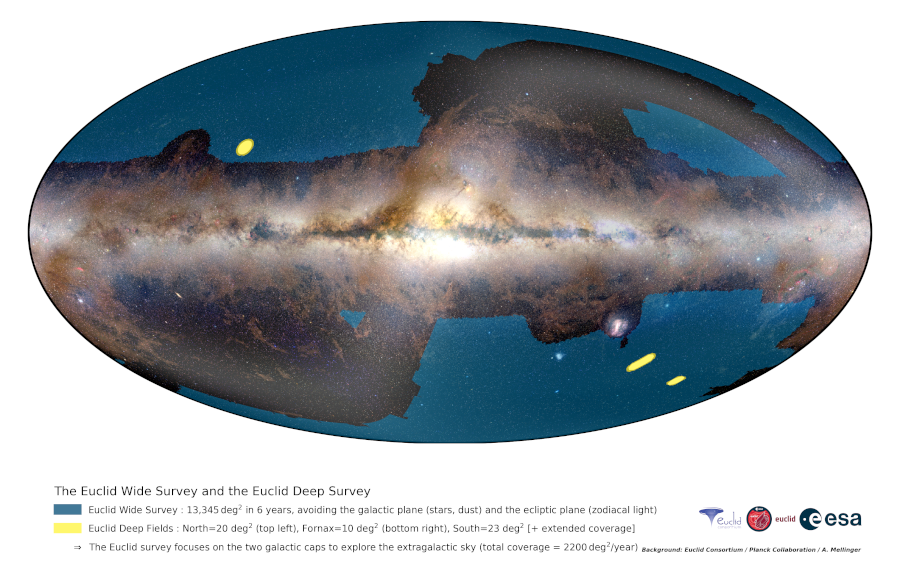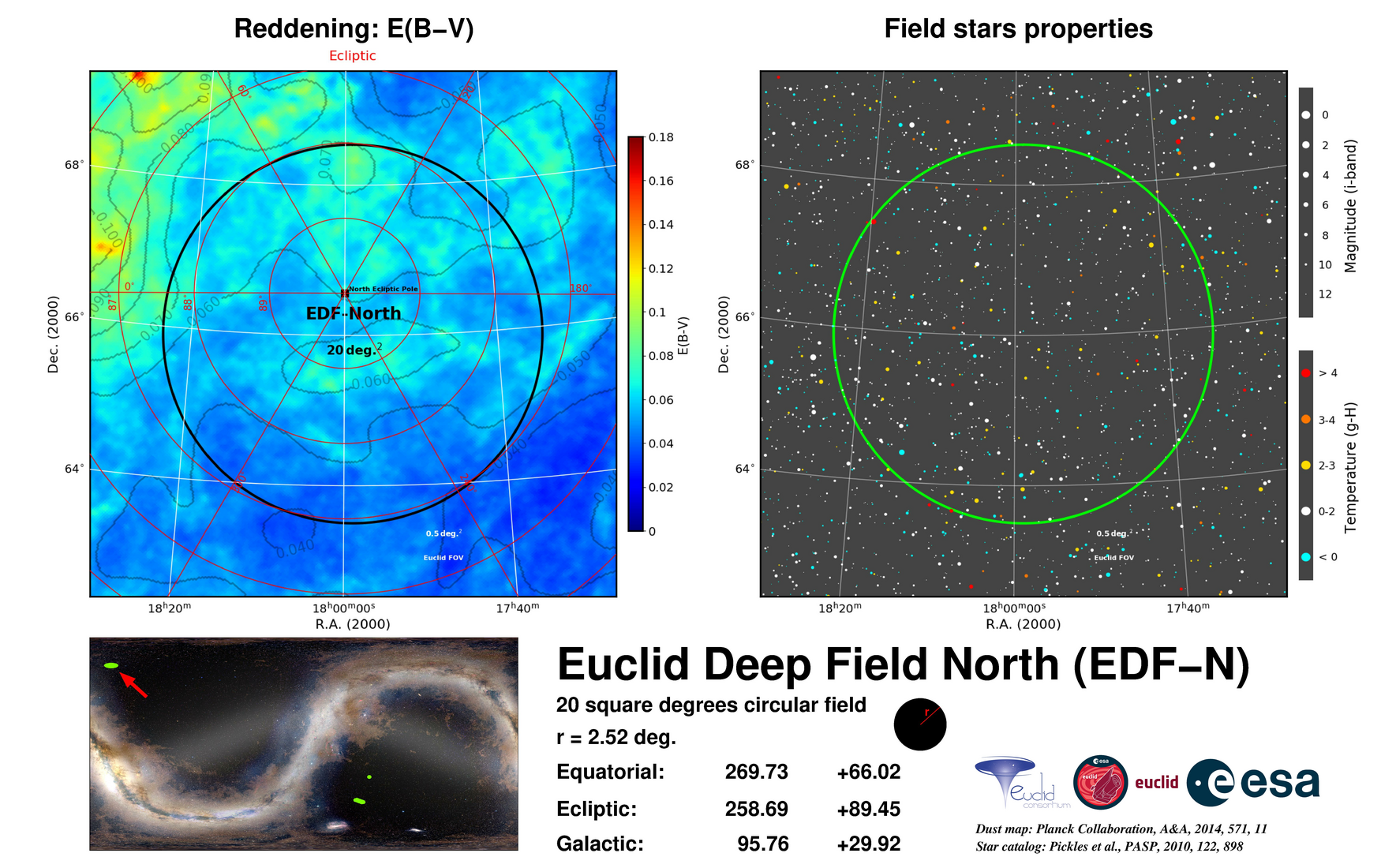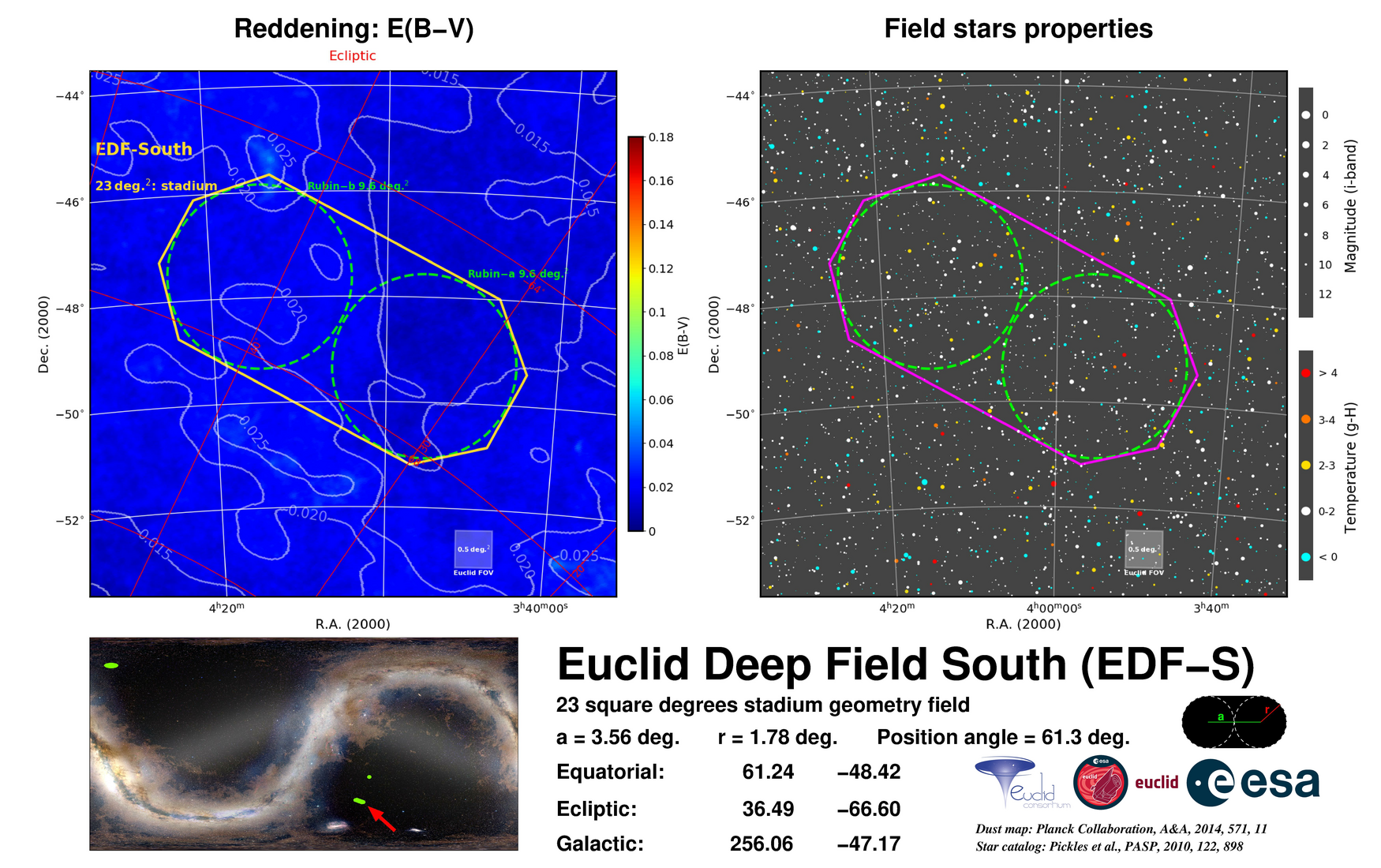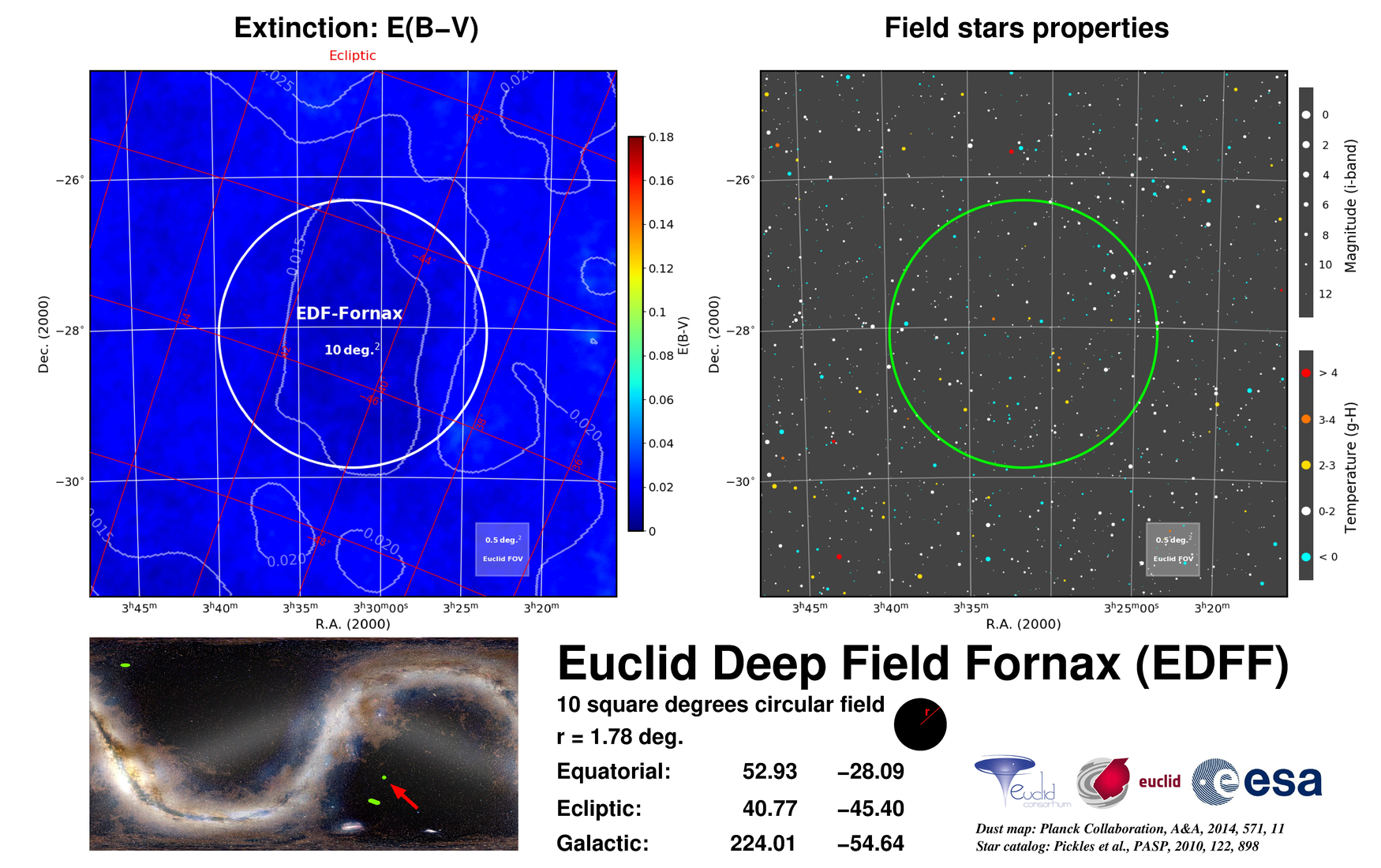Euclid Survey - Euclid
The Euclid Survey
The Euclid survey is aimed at covering a very large area of the sky with both Euclid instruments (the visible wide-field camera VIS, and the Near-Infrared Spectrometre and Photometre NISP) in order to obtain a large common coverage of the Extragalactic sky for both main core cosmology probes: weak lensing and galaxy clustering.
We give below an overview of the wide and deep surveys that will be observed by Euclid. Detailed information about where Euclid is observing during its nominal mission, meant for the scientific community, are also available here.
Wide Field
The Wide Survey will cover at least 14000 square degrees of the sky, avoiding the Galactic plane where stellar density is too high, and the Ecliptic plane where the zodiacal background is too high, and it will use about 66% of the total mission time.
Deep Fields
Euclid will also observe three Deep Fields on selected areas of the sky: the EDF-North, centred around the northern Ecliptic pole, the EDF-South (stadium-shaped) and the EDF-Fornax, whose characteristics can be found in the pictures below. The location of the three Euclid deep fields have been selected by the Euclid Sky Survey Working Group of the Euclid Consortium. The position of the Euclid Deep Fields – one in the northern sky and two in the southern sky – was announced during the 2019 annual consortium meeting in Helsinki, Finland.
See ESA web story on: Three dark fields for Euclid's deep survey.
These three dark patches of the sky will be the subject of the mission's deepest observations, aiming at exploring faint objects in the early Universe as well as assessing the purity of the spectroscopic observations in the Wide Survey. The visits to the Deep Fields happen at regular intervals during the mission, in order to increase the signal to noise two magnitudes deeper than the Wide Survey, and cover them with different observation angles. The Deep Fields take up 13% of the total survey time.
The 3 Euclid Deep Fields (EDFs) are specified as follows, in Equatorial (celestial) coordinates (RA/Dec.):
- EDFN (North) - 17:58:55.9 +66:01:03.7
- 20 deg2 x 40 visits
- EDFS (South) - 04:04:57.84 -48:25:22.8
- 23 deg2 x 45 visits
- Note that the exact centre of the EDFS has been slightly modified July 10th, 2019. The updated EDFS octagon stadium envelope is:
63.25 -45.67
65.35 -46.10
66.40 -47.25
65.99 -48.72
59.25 -51.19
56.95 -50.82
55.90 -49.40
56.80 -47.99
- EDFF (Fornax) - 03:31:43.6 -28:05:18.6
- 10 deg2 x 52 visits, 7 visits within a few hours-days every ~9 months
"Blue" grism data will be obtained for all observations of the 3 deep fields, as opposed to the Wide Survey where only "red" grism data will be obtained. See also NISP description at https://sci.esa.int/web/euclid/-/euclid-nisp-instrument.
The Euclid deep field spectroscopy data will be a unique dataset since there are no slitless surveys implemented with such a large number of grism orientations. The deep fields will be crucial to asess the purity and completeness of the wide field.
The Euclid deep fields will be also covered in depth by the Rubin telescope.
Calibration Fields
Additionally, the calibration needs of Euclid imply that a number of calibration block sequences are planned at regular interval during the mission. Overall, the calibration time during routine phase represents 12% of the total mission time.
Unallocated time
About 5% of the total time is currently unallocated, meaning that the core cosmology region of interest cannot be observed during these periods. This happens during the late years of the mission. These periods can be used for operational needs (to re-plan previously missed or badly-observed areas). Should unallocated time remain in the later years of the mission after all the necessary survey re-plannings, those areas will be filled in with dedicated legacy programs.
The Euclid wide and deep surveys. Credit: ESA/Euclid Consortium. Acknowledgment: Euclid Consortium Survey Group
Mollweide projection of the whole sky in Galactic coordinates. The Wide Survey appears in blue (two large “continents” and two smaller “islands”), while the non-observed areas appear in brown/black with the visible emission of the Milky Way (concentrated in the Galactic plane) and the zodiacal light (in the Ecliptic plane). The three Euclid Deep Fields are shown in bright yellow (North, South – Stadium shape, and Fornax, from top to bottom).
More information about the deep fields
1. Euclid Deep Field North (EDFN)
The Euclid Deep Field North – highlighted in yellow, towards the top left of the image above – has an area of 20 square degrees and is located very close to the Northern Ecliptic Pole, in the constellation Draco, the dragon. The proximity to the ecliptic pole ensures maximum coverage throughout the year; the exact position was chosen to obtain maximum overlap with one of the deep fields surveyed by NASA's infrared workhorse, the Spitzer Space Telescope.
Based on the need for a larger area of calibration observations for the Euclid spectroscopic sample characterisation, the Euclid Science Team has endorsed in April 2022 the request to extend the Euclid Deep Field North from 10 deg2 to 20 deg2.
The EDF-N started being observed during the first year of survey, partly as CPC-N observations. These CPC-N observations are complete after now two years of survey (some needed to be repeated). The EDF-N is then observed regularly until the fifth year, when the final observations will be taken.
In total, the current survey plan (RSD 2025 A) schedules 32 passes over EDF-N and 12 CPC-N passes (among which two are repeated).
This mosaic exhibits the Euclid Northern Deep Field area overlaid on the reddening magnitude (B-V) levels (top left) – the redder the area, the more reddening there is due to cosmic dust absorption of the visible light; the properties of the field stars in the same area (top right), showing the colour and magnitude of each major star; the location of the EDF-N in the whole sky (bottom left), and the coordinates of the centre of the circular Deep Field (bottom right).
2. Euclid Deep Field South (EDFS)
During the second survey year, 7 passes of EDF-S are scheduled, followed by 8 passes in the third year, 8 passes in the fourth year and 8 in the fifth year. The last year will allow to complete the EDF-S observations with four passes (35 passes in total, in order to compensate for the higher background on the EDF-S compared to the EDF-N).
This mosaic exhibits the Euclid Southern Deep Field area ("stadium" shaped) overlaid on the reddening magnitude (B-V) levels (top left) – the redder the area, the more reddening there is due to cosmic dust absorption of the visible light; the properties of the field stars in the same area (top right), showing the colour and magnitude of each major star; the location of the EDF-S in the whole sky (bottom left), and the coordinates of the centre of the stadium-shaped Deep Field (bottom right).
3. Euclid Deep Field Fornax (EDFF)
The EDF-F is typically observed twice a year, starting in the middle of the first year, for 52 visits in total. It was observed once (x2) in the first survey year, then it will be observed twice (x5, x5) in the second survey year (a survey year starts on Feb. 14th) and twice (x5, x5) during the third year. During the fourth and fifth survey years, it will also be observed twice per year (x5, x7), and finally, once in the sixth year (x6).
This mosaic exhibits the Euclid Fornax Deep Field area overlaid on the reddening magnitude (B-V) levels (top left) – the redder the area, the more reddening there is due to cosmic dust absorption of the visible light; the properties of the field stars in the same area (top right), showing the colour and magnitude of each major star; the location of the EDF-F in the whole sky (bottom left), and the coordinates of the centre of the circular Deep Field (bottom right).








































 Sign in
Sign in
 Science & Technology
Science & Technology



